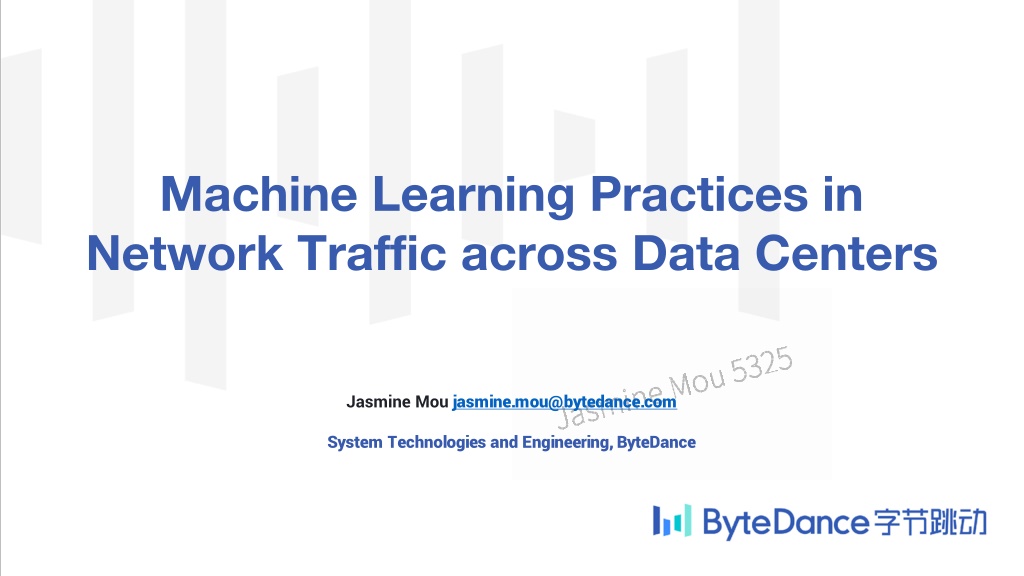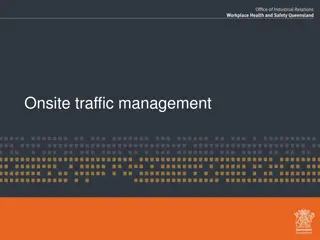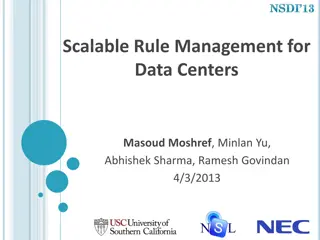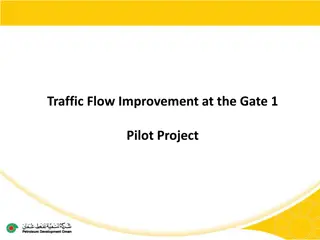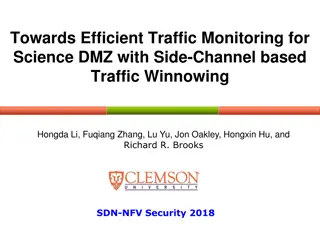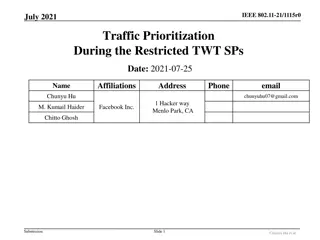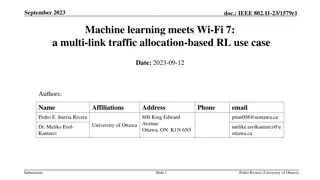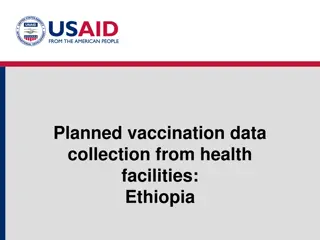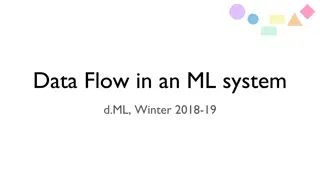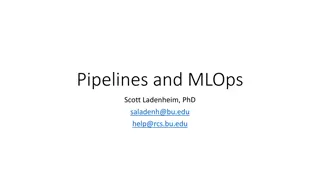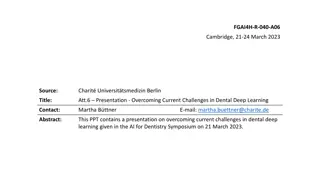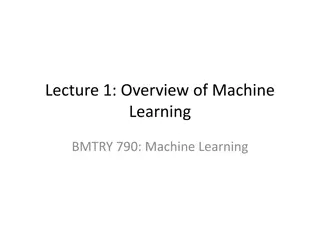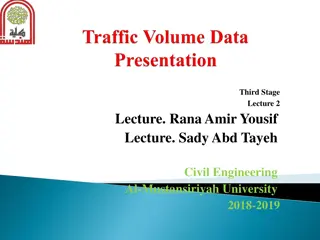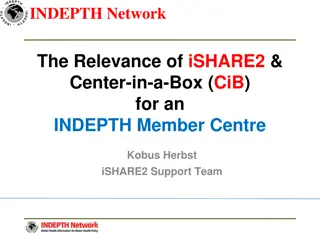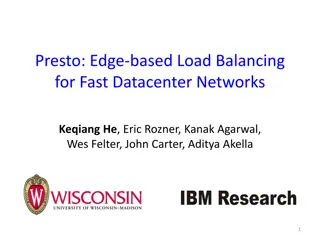Machine Learning Practices in Network Traffic Across Data Centers
This presentation focuses on machine learning practices in managing network traffic across data centers. It covers topics such as context and challenge definitions, machine learning approaches, unexpected traffic scenarios, major contributors, resource planning, and problem definitions related to traffic trends, major contributors, and capacity projections. The goal is to enhance network traffic management efficiency and service stability.
Download Presentation

Please find below an Image/Link to download the presentation.
The content on the website is provided AS IS for your information and personal use only. It may not be sold, licensed, or shared on other websites without obtaining consent from the author. Download presentation by click this link. If you encounter any issues during the download, it is possible that the publisher has removed the file from their server.
E N D
Presentation Transcript
Machine Learning Practices in Network Traffic across Data Centers Jasmine Mou jasmine.mou@bytedance.com System Technologies and Engineering, ByteDance
Agenda Context & Challenge Problem Definitions Machine Learning Approaches and Applications Data Pipeline Summary
Context - Network traffic model Network traffic flow Dimensions defining the network traffic Location: src/dst --Backbone, data center, group unit location, TOR, server Time: timestamp route: capacity product pairs: compute & storage, Message Queue, Yarn, HDFS,... traffic Top to down: overall traffic -> pairs of product from pairs of source and destination -> services. Bidirectional. The number of dimensions increases the complexity for network traffic management. 3
Context - Unexpected traffic Delivery goals in Networking ensure service stability. catch up with service traffic growth --may consider the capacity expansion when necessary. Cross Data Center traffic Traffic within DC is always more preferable than traffic across DC. Need to limit and optimize such traffic to save the costs. Expected vs Unexpected Expected: predefined list of route location and product pair. Unexpected: traffic caused by those that are not on the list. 4
Context - Major Contributors When "unexpected" traffic happens, Network engineers need to know Sudden increase in unexpected traffic in this route. influence of unexpected traffic vs overall traffic. time window, especially during the peak hours. which product pairs are the major contributors. 5
Context - Resource planning The need to expand the route capacity ahead of time Deliver smoother network experience. Resource planning workflow Collect the future deployment needs for product pairs. Check historical traffic data, and servers resource usage and utilization. Estimate number of servers needed to supply. Challenge: mixed deployment on the same server. 6
Problem Definitions We want to Answer 3 Questions: 1. Can we discover the trend in traffic, esp. long-term, and provide forecast to alert when the traffic hit the watermark level in recent future (~60 days)? 2. Can we find out the major contributors to the traffic, so to locate the high priority focus? 3. Can we have a projection tool to check capacity capability when updating the number of servers available for a product pair on src and dst ends? 7
Machine Learning Apps - Toolbox Statistical features Quantitative stats: mean/median/mode, variance/std. dev. Data distribution: shape, kurtosis, skewness. Regression modeling Given independent variables Xs, predict the dependant variable y. Time series modeling Subcategory of regression modeling. Variable X are autocorrelated in time. Anomaly detection Identification of unexpected events that are deviated from the observed "normal" events. 8
Machine Learning Apps Tools alignments: algorithms & statistical profiling Q1. Trend & Forecast Q2. Major Contributors Q3. Resource Projection Topic Statistical Features Time Series Anomaly Detection Regressions 9
Machine Learning Apps - Trend & Forecast Workflow 1. Extract statistical features: hourly P99. 2. Apply time series algorithm Decompose data into trend, seasonality, noise. Cluster to discover series with common patterns. 3. Apply anomaly detection: use change points detection to segment the data. 4. Apply lasso regression over peaks from last trend to forecast. 10
Machine Learning Apps - Major Contributors Workflow 1. Extract statistical features: daily max. 2. Calculate statistics (a) Ratios of unexpected vs overall. (b) Ring ratios of (a) to reflect the chronological changes. 3. Rank by the statistics calculated in step 2 and pick top N entities (products, services,...). 11
Machine Learning Apps - Resource Projection Workflow 1. Extract statistical features: counts of hosts on both src & dst for each product pair. 2. Fit Regression methods (Linear Regression, Ridge Regression, ...) to project the capacity using historical counts & capacity data for each product pair. 12
Data Pipeline Pipeline Diagram Data processing steps 1. Clean & Aggregate data Clean & Aggregate: remove negatives; interpolate to fill NA. Transform: different granularity, traffic data, product pairs data. 2. Apply the algorithm workflow. 3. Save results (calculation, data viz). 13
Data Pipeline Computation & Scheduled Jobs Internal DAG platform designed specifically for machine learning jobs Update frequency Q1. Trend & Forecast Daily Q2. Major Contributors Daily Q3. Resource Projection Freq/Question Scheduled Jobs On-demand 14
Data Pipeline Storage Input: MySQL, Hive. Output HDFS -cached intermediate results. MySQL -analytical summary & time series features. Object Storage -data viz. Output format Q1. Trend & Forecast Customized Chatbot Q2. Major Contributors Q3. Resource Projection Medium/Question Tables in DB Message subscription RESTful API 15
Summary Context & challenges Network traffic models Save the cost by increasing the supply & decreasing the demand Unexpected traffic Resource planning Define the problems into 3 model apps Trend & forecast Major contributors Resource projections Machine learning apps Data pipeline: workflow, computing & storage. 17
